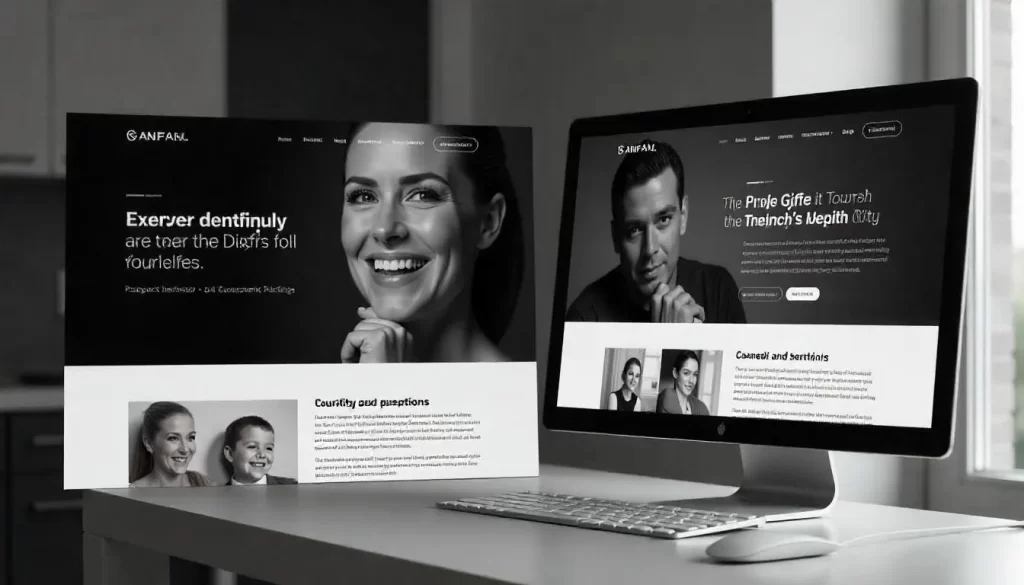
Related Posts
- What to Look for in a Dental-Specific Web Designer
- How to Build or Access a Professional Site on a Budget
- Why Most Dental Website Traffic Comes from Mobile and How to Optimize
When it comes to dental websites, one size doesn’t fit all. Each type of dental practice whether pediatric, cosmetic, or specialty dentistry, requires a unique approach to web design that speaks directly to its target audience. The visual elements, messaging, and user experience must be tailored to address the specific needs and concerns of the patient demographic. In this article, we’ll explore how to adapt your dental website design for pediatric, cosmetic, and specialty practices, ensuring that your site not only attracts visitors but also converts them into loyal patients.
When it comes to dental websites, one size doesn’t fit all. Each type of dental practice whether pediatric, cosmetic, or specialty dentistry, requires a unique approach to web design that speaks directly to its target audience. The visual elements, messaging, and user experience must be tailored to address the specific needs and concerns of the patient demographic. In this article, we’ll explore how to adapt your dental website design for pediatric, cosmetic, and specialty practices, ensuring that your site not only attracts visitors but also converts them into loyal patients.

Pediatric Dental Website Design – Crafting a Child-Friendly Experience
Understanding the Pediatric Demographic
When designing a website for a pediatric dental practice, the focus should be on creating a warm, welcoming, and child-friendly atmosphere. Parents are the ones making the appointment, but it’s the kids who need to feel comfortable and at ease. Therefore, your website design must appeal to both parents and children in a way that promotes trust and comfort.
Expert Insight: A pediatric dental website should use playful colors, fun graphics, and simple navigation to make children feel like they’re entering a friendly, non-threatening environment. For parents, clear information about services, safety measures, and child-specific treatments must be easily accessible.
Child-Friendly Design – Visuals and Navigation
The first impression your website makes is crucial, especially when it comes to pediatric dentistry. The design should evoke a sense of safety, joy, and trust. Bright colors, friendly characters, and engaging animations can make a significant impact on children and their parents. Use of fun, approachable typography and age-appropriate visuals can help establish this welcoming atmosphere.
Related Posts
- Why Most Dental Website Traffic Comes from Mobile and How to Optimize
- Adapting Design to Specific Practice Types
- How to Build or Access a Professional Site on a Budget
Microsemantic Entity: Child-friendly design is essential in creating a website that feels approachable to kids and comforting to parents.
Key design features for pediatric sites include:
- Bright, playful colors: Soft blues, greens, and pastel colors can make the website feel less clinical and more fun.
- Cartoonish elements: Use mascots or friendly characters that children can relate to.
- Easy navigation: Use simple, clear menus with large buttons for ease of use, particularly for parents who may be juggling multiple tasks.
Urgency-Focused CTAs for Appointments
For pediatric dental practices, it’s crucial to make appointment booking as easy and urgent as possible. Parents often need quick solutions, especially if their child is experiencing discomfort or pain. Your website’s calls to action (CTAs) should be highly visible and convey urgency.
Expert Insight: CTAs like “Book Your Child’s Appointment Now” or “Emergency Pediatric Care” should be placed prominently throughout the site, ensuring that parents don’t have to search for how to schedule an appointment.
Cosmetic Dental Website Design – Luxury Aesthetic and Trust
Understanding the Cosmetic Demographic
When designing a website for a cosmetic dental practice, the target demographic is typically adults seeking to improve their appearance. Cosmetic dentistry is all about enhancing aesthetics, so the website design must reflect the high-end, professional services you offer. The goal is to make potential patients feel confident in your ability to deliver top-notch results.
Expert Insight: A cosmetic dental website should emphasize a luxurious aesthetic, showcasing the quality of your services and the transformations patients can expect. Clean, modern designs with sophisticated typography and elegant visuals should convey professionalism and expertise.
Luxury Aesthetic and High-End Design
Cosmetic dentistry is often associated with premium services, and your website should reflect that luxury. The design should be sleek, modern, and elegant, with high-quality images and smooth transitions that evoke sophistication.
Microsemantic Entity: Luxury aesthetic design should include modern color schemes (like white, gold, and silver), minimalistic layouts, and high-end typography.
Key design features for cosmetic dental websites include:
- Sophisticated color palettes: Use a minimalist approach with high-end shades like black, white, or metallics that reflect luxury and elegance.
- High-quality imagery: Showcase before-and-after photos of successful treatments, along with testimonials from happy patients.
- Refined typography: Opt for serif fonts or modern sans-serif typefaces that convey professionalism and high-class services.
Building Trust with Before-and-After Galleries
One of the most effective ways to build trust with potential cosmetic patients is by showcasing your work. A before-and-after gallery provides visual proof of the transformations you can offer. This feature not only shows your skill but also helps patients visualize their potential results.
Expert Insight: A picture is worth a thousand words. High-resolution before-and-after images can be the deciding factor for someone considering cosmetic dental treatments.
Specialty Dental Website Design – Catering to Niche Services
Understanding the Specialty Demographic
Specialty dental practices such as orthodontics, periodontics, or oral surgery cater to a specific patient demographic that requires more detailed and specialized care. These patients are often seeking solutions for complex issues, and they need to feel reassured that they are in the hands of a highly skilled professional.
Expert Insight: The website design for specialty dental practices should be informative and authoritative, highlighting the specialized services offered and positioning the practice as an expert in that field. Visitors should quickly understand what sets your practice apart in terms of qualifications and services.
Niche Services and Expertise-Focused Design
The design for a specialty dental practice should be clean and professional, with an emphasis on expertise. Detailed service pages explaining the specific treatments offered, patient testimonials, and the credentials of the dental team are critical for establishing trust.
Microsemantic Entity: Specialty icons can help represent niche services, such as an icon for orthodontics or implants, making it easier for patients to find the information they need.
Key design features for specialty dental websites include:
- Expertise-focused content: Include detailed explanations of procedures, conditions treated, and the latest technologies or treatments you use.
- Specialty icons: Use visual icons that represent specific services, like braces for orthodontics or a tooth implant icon for oral surgery.
- Patient education: Offer educational resources, such as videos or blog posts, to inform patients about procedures and what to expect.

Adapting to Patient Demographics and Behavior
Age-Appropriate Visuals and Messaging
The key to designing a successful dental website for any practice type is understanding the specific patient demographic. For pediatric dentistry, that means using playful, bright visuals. For cosmetic dentistry, the focus is on luxury and sophistication. For specialty dental practices, the emphasis should be on professional expertise and trustworthiness.
Expert Insight: Adapt your messaging to the concerns and motivations of your target audience. Parents of young children will respond to messages about safety and comfort, while adult patients seeking cosmetic work will focus more on aesthetics and transformation.
Tailored User Experience (UX) for Different Needs
Each dental practice type requires a different user experience. Pediatric practices need quick, easy appointment scheduling and child-friendly navigation. Cosmetic practices need sleek, easy-to-navigate websites with beautiful visuals. Specialty practices need informative websites that highlight expertise and provide in-depth service details.
Expert Insight: Customizing the user journey based on patient needs ensures that your website will convert visitors into patients. For example, a cosmetic dentist might include a “Free Consultation” CTA, while a pediatric dentist would focus on “Emergency Appointments” and “Quick Scheduling.”
Related Posts
- Must-Have Elements That Convert Visitors to Patients
- Back-End Essentials for Reliability, Compliance, and Trust
- Where to Find Fresh Ideas and Visual Direction
Designing Websites for Specific Dental Practices
Adapting your website design to the specific type of dental practice you operate is crucial for engaging and converting patients. Pediatric, cosmetic, and specialty dental websites all require unique approaches to design that cater to their distinct patient demographics. Whether it’s creating a child-friendly, comforting atmosphere, reflecting luxury and sophistication for cosmetic dentistry, or showcasing expertise for specialty services, the right design can help your practice build trust, demonstrate authority, and drive conversions.
Key Takeaways:
- Pediatric websites should focus on child-friendly design with playful visuals, easy navigation, and urgency-driven CTAs.
- Cosmetic dental websites need a luxury aesthetic, showcasing transformations with before-and-after galleries and trust-building elements.
- Specialty dental websites should emphasize expertise and niche services, with informative content and professional visuals to build authority.
FAQs:
How can I adapt my dental website design for different practice types?
Each type of dental practice requires a different approach. Pediatric websites should be playful and welcoming, cosmetic websites should have a luxurious feel, and specialty websites should emphasize professionalism and expertise.
What are the best design features for a pediatric dental website?
For pediatric websites, use bright colors, fun graphics, and easy navigation. Ensure that CTAs are visible and convey urgency for appointment booking.
How do I build trust on a cosmetic dental website?
Showcase high-quality before-and-after photos, include patient testimonials, and use a sleek, elegant design with sophisticated typography to reflect the luxury of your services.
What should a specialty dental website focus on?
A specialty dental website should focus on expertise, with detailed service pages, patient education, and specialty icons to represent niche services.
